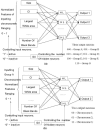Automated classification of metaphase chromosomes: optimization of an adaptive computerized scheme
- PMID: 18585097
- PMCID: PMC2673199
- DOI: 10.1016/j.jbi.2008.05.004
Automated classification of metaphase chromosomes: optimization of an adaptive computerized scheme
Abstract
We developed and tested a new automated chromosome karyotyping scheme using a two-layer classification platform. Our hypothesis is that by selecting most effective feature sets and adaptively optimizing classifiers for the different groups of chromosomes with similar image characteristics, we can reduce the complexity of automated karyotyping scheme and improve its performance and robustness. For this purpose, we assembled an image database involving 6900 chromosomes and implemented a genetic algorithm to optimize the topology of multi-feature based artificial neural networks (ANN). In the first layer of the scheme, a single ANN was employed to classify 24 chromosomes into seven classes. In the second layer, seven ANNs were adaptively optimized for seven classes to identify individual chromosomes. The scheme was optimized and evaluated using a "training-testing-validation" method. In the first layer, the classification accuracy for the validation dataset was 92.9%. In the second layer, classification accuracy of seven ANNs ranged from 67.5% to 97.5%, in which six ANNs achieved accuracy above 93.7% and only one had lessened performance. The maximum difference of classification accuracy between the testing and validation datasets is <1.7%. The study demonstrates that this new scheme achieves higher and robust performance in classifying chromosomes.
Figures








References
-
- Tjio JH, Levan A. The chromosome number in man. Hereditas. 1956;42:1–6.
-
- Conference D. A proposed standard system of nomenclature of human mitotic chromosomes. Lancet. 1960;1:1063–5. - PubMed
-
- Piper J, Granum E, Rutovitz D, Ruttledge H. Automation of chromosome analysis. Signal Processing. 1980;2:203–21.
-
- Wang X, Zheng B, Wood M, Li S, Chen W, Liu H. Development and evaluation of automated systems for detection and classification of banded chromosomes: current status and future perspectives. J Phys D Appl Phys. 2005;38:2536–42.
-
- Groen F, Kate Tt, Smeulders A, Young I. Human chromosome classification based on local band descriptors. Pattern Recognition Letters. 1989;9:211–22.
Publication types
MeSH terms
Grants and funding
LinkOut - more resources
Full Text Sources
Other Literature Sources

